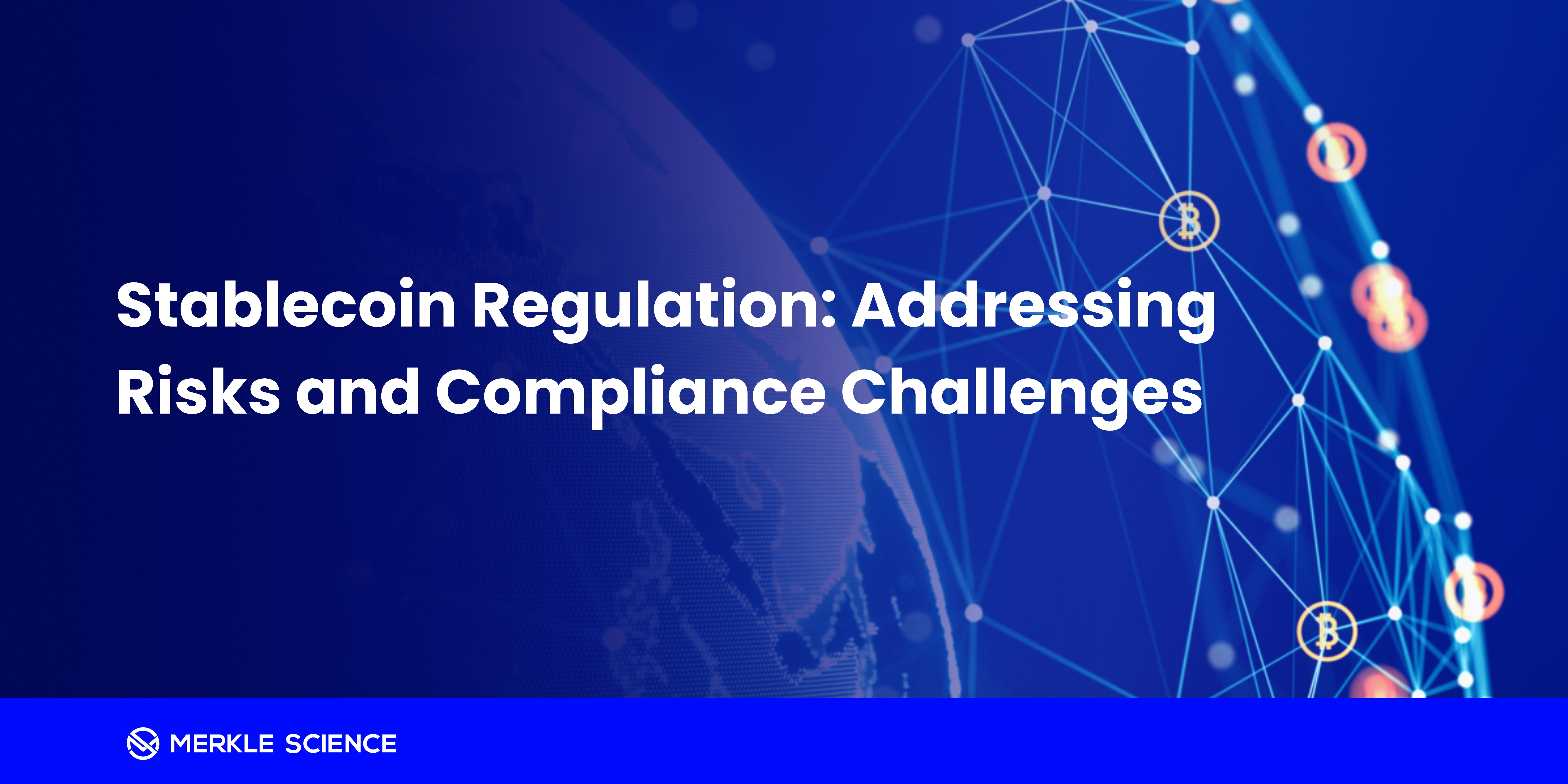Stablecoin Regulation: Addressing Risks and Compliance Challenges

Merkle Science

Introduction
Stablecoins are cryptocurrencies designed to maintain a stable value by being pegged to a fiat currency or other assets. Their core advantage is the price stability that facilitates transactions and participation in decentralized finance. However, their main disadvantages include potential regulatory risks, as increased scrutiny and evolving regulations could impact their usage and acceptance, as well as centralization and transparency issues that pose significant compliance challenges.
Businesses that interface with stablecoins must comply with a complex regulatory environment that aims to ensure their stability and trust. They must meet varying and ever-changing policies in know-your-customer (KYC), anti-money laundering (AML), and countering the financing of terrorism (CFT).
Businesses must understand this stablecoin regulatory landscape and corresponding risks to overcome challenges in compliance.
Understanding the Stablecoin Regulatory Landscape
The United States, which has often led the world in cryptocurrency legislation, is taking a progressive stance toward stablecoins. In November 2021, the US Department of Treasury published a Report on Stablecoins which summarized the numerous risks associated with stablecoins and then made a recommendation:
"To address the prudential risks of payment stablecoins, the President’s Working Group on Financial Markets (PWG), along with the Federal Deposit Insurance Corporation (FDIC) and the Office of the Comptroller of the Currency (OCC) (together, the agencies) recommend that Congress act promptly to enact legislation to ensure that payment stablecoins and payment stablecoin arrangements are subject to a federal prudential framework on a consistent and comprehensive basis."
That challenge was taken up by Senators Cynthia Lummis and Kirsten Gillibrand in April 2024, when they proposed the Lummis-Gillibrand Payment Stablecoin Act of 2024.
The Lummis-Gillibrand Payment Stablecoin Act of 2024 was made with the aim of facilitating innovation related to stablecoins. “The possibilities for using stablecoins are numerous, and we are just starting to see how financial innovation will thrive once stablecoins become a common form of payment,” wrote both senators in a CoinDesk op-ed, entitled, The Solution for Stablecoin Regulation.
The Lummis-Gillibrand Payment Stablecoin Act of 2024 involves the Federal Reserve working alongside other agencies and state regulators to oversee stablecoin issuers, establishes detailed custodianship policies, and provides protections for customers to receive funds in the event of an issuer's bankruptcy.
In Europe, the Markets in Crypto Assets Regulation (MiCA) has provided regulatory guidance on stablecoins. The legislation affirms that stablecoin issuers must comply with the electronic money directive (EMD) passed in 2000 and thus be regulated as electronic money institutions (EMIs), similar to mobile wallet providers. Furthermore, these EMIs that issue stablecoins must
comply with additional requirements set forth by MiCA. Reserves must be held on a 1-to-1 basis for any stablecoin, and as a result, stablecoins based on an algorithm rather than underlying asset are also prohibited. Businesses that fail to comply with these requirements face potential fines and criminal charges.
In Southeast Asia, the Monetary Authority of Singapore (MAS) finalized a regulatory framework on stablecoins in August 2023. The framework defined stablecoins as “digital payment tokens designed to maintain a constant value against one or more specified fiat currencies,” and must meet requirements in information disclosure, capital, value stability, and redemption at par, giving stablecoin issuers 5 days to return the value of any single-currency stablecoin (SCS).
In short, stablecoin regulation is advancing progressively and rapidly in major business hubs around the world, and businesses in the space need to comply to stay ahead.
Risks Associated with Stablecoins
Following our exploration of the stablecoin regulatory landscape, it’s crucial to delve into the various risks associated with stablecoins, which can significantly impact their stability and broader adoption.
These risks include factors such as liquidity challenges, scalability issues, volatility, cybersecurity threats, and legal and compliance concerns. Businesses should understand these risks to properly evaluate the potential hurdles and safeguards necessary for stablecoin integration into the financial ecosystem.
Let's take a closer look at the main risks that stablecoins face:
- Liquidity - Some stablecoin issuers have faced criticism on the transparency of its reserves, and whether its stablecoin is really backed by a corresponding amount of its underlying asset.
Tether faced criticism regarding the transparency of its reserves and whether its stablecoin is fully backed by corresponding assets. In response, Tether has been providing regular attestations of its reserves. Initially, these attestations were provided quarterly, then moved to monthly, and more recently, Tether announced plans to offer real-time reserve data updates starting in 2024. - Scalability - When stablecoins reach critical mass, the blockchains they operate on can become congested with traffic, slowing transaction times. This issue has frequently happened to Tether on Ethereum. This situation creates a negative feedback loop: gas prices become higher, making the stablecoin impractical to use; and user confidence in the asset is undermined, which ultimately hinders consumer buy-in and scalability of the coin.
- Volatility - One of the most famous stablecoins was Luna, which was tied to TerraUSD (UST). In May 2022, Luna fell into a downward spiral that saw its value crash by 99.99% to fractions of a penny. This incident highlights the volatility of stablecoins, which are only as stable as the underlying assets they are pegged to. While algorithmic stablecoins like Luna are particularly vulnerable, stablecoins tied to fiat currencies or other commodities are also subject to volatility. This volatility makes stablecoins difficult to use as a medium of exchange.
- Cybersecurity - Stablecoins are subject to the wide variety of hacking threats and exploits that are a risk to other digital assets, and face some special dangers. For example, some stablecoins are decentralized and governed by smart contracts, such as DAI and FRAX. These decentralized stablecoins are subject to the attack vectors as other smart contract-backed assets documented by the OWASP Top 10, including reentrancy attacks, integer overflow and underflow, timestamp dependance, and more. Hackers can also target the reserves of a stablecoin’s underlying assets, which would negatively impact its value.
- Legal and compliance risks - Like other digital assets, stablecoins can be acquired with some degree of anonymity, which makes it ideal for use by criminals. Authorities rightfully fear that stablecoins will be used for terrorist financing, or to launder money from other critical enterprises. Stablecoin issuers - and the entities that regulate them - must therefore ensure there are robust AML and CFT measures.
In short, stablecoins are subject to the same risks that affect other digital assets as well as some that are unique to them.
Compliance Challenges with Stablecoins
Stablecoin issuers, exchanges, and other stakeholders must comply with a complex regulatory environment. They must comply with both KYC and anti-money laundering (AML) regulations, which will vary from market to market and can even change rapidly within the same market.
KYC procedures are particularly difficult because businesses have tended to operate around blacklists. If a customer is a part of a sanctioned entity, the organization will not do any business with them. The problem with this kind of KYC approach is that the vast majority of risks are not so black-or-white. It is more common to find individuals who have some type of risk, but who are not a part of any official blocklist, such as wallets that may be linked to - but not owned by - criminals or entities under sanctions.
The businesses that operate exclusively through blacklists will necessarily miss out these affiliated individuals and wallets. It is indeed very difficult to maintain a risk-based approach toward conducting KYC rather than the either-or strategy executed through blocklists.
Businesses face the same challenges in AML prevention with stablecoins as they do with other digital assets. Criminals that launder money know how to obfuscate their trail, using a variety of common techniques. They may hack from blockchain to blockchain, a technique known as chain-hopping, to make it difficult for investigators to follow their trail. They may use coin mixers, which pool funds with other sources, mix in together, and output the same amount in different coins.
Failing to comply with KYC and AML incur severe direct and indirect penalties. Businesses must face fines, punishments, and other sanctions. The implicit consequences are arguably just as stiff. Businesses who fail to comply will invite more government scrutiny, risk the ire of legitimate customers, and lose brand equity.
The best way to combat the challenges associated with KYC and AML policies is through the growing field of blockchain analytics. With the right blockchain analytics tool, businesses can take a more sophisticated approach to KYC than simply a blocklist, evaluating new and current users based on behavior-based rules that are fully customizable. Furthermore, in the event of a criminal incident, businesses can use blockchain analytics to track down the illicit funds, even if the criminals use obfuscation techniques. These tools can also assist with real-time monitoring and also utilize alerts, so that businesses quickly learn of any suspicious transactions and can take prompt action.
Merkle Science Solutions
Merkle Science has a suite of blockchain analytics solutions that make it easy for businesses to address the KYC, AML, and CFT risks associated with stablecoins. Businesses can elevate their KYC procedures with the behavior-based rules and alerts of Compass, visualize the flow of illicit funds across complex trails with Tracker, and even conduct due diligence on potential stablecoin exchanges through know your blockchain business (KYBB).
Contact Merkle Science for a free demo on any one of these solutions, so your business can remain compliant in its use of stablecoins.


